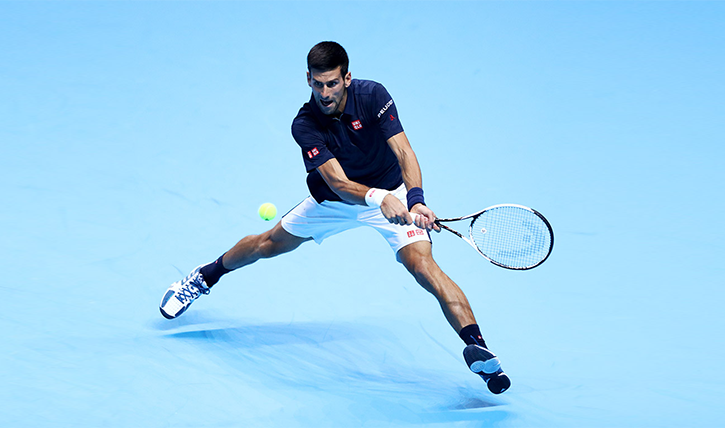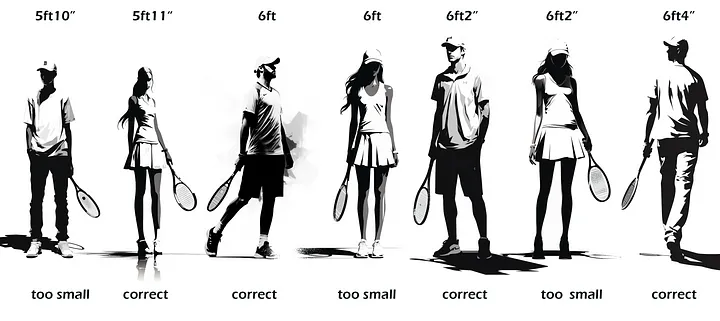The forehand is the principle shot in tennis. Outside of the serve, the forehand produces most winners, and most successful defensive shots. In short, your forehand quality predicts your overall grade of tennis from beginner (flat), improver (curved) and expert (topspin). Today I am going to look in depth at the forehand technique.
The Forehand is Counter Intuitive
It’s hard to explain but the better you are at tennis, the more the ball does not go where you hit it!!
As a beginner, the ball bounces off the strings roughly in the direction of the racket face, so your job is to simply point the racket face in the direction you want the ball to go, and then decide how hard to hit….so that the ball goes in. Imagine the newtonian physics of a game of 8 ball pool. It’s like that.
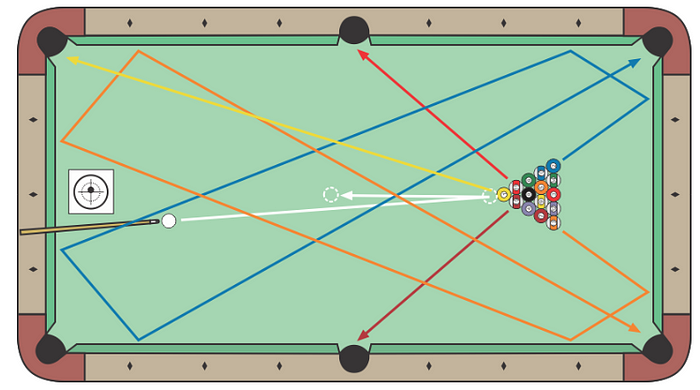
But as a tennis expert, the ball flies rises higher than expected and falls quicker than expected due to impressive spin. The spin introduces an arc which keeps the ball in. The ball spends longer on the strings than a beginners shot because A. the strings deviate up to an inch on contact, and B. the force imparted with a glancing brushing-angle with the ball is actually less than a direct force, which means more not less control. Paradoxically the ball is not hit straight. And of course the tennis ball is hit harder than seems feasible in order to keep the ball in! Paradoxically the ball is hit super-hard.
Paradox 1. the ball is hit hard …….but lands in
Paradox 2. the ball is at an angle ……..but goes where it is wanted
Paradox 3. nothing seems to line up…….but there is high precision!
To impart forward motion AND spin, the ball is covered in grippy felt which creates a lot of friction between the ball and the strings. BUT 90% of the spin comes from the hitting action, not just the strings. 9% comes from the strings / ball, and just 0.9% from the frame. That’s my tennis rule of 9’s. 90,9,0.9.
Spin is 90% technique
Spin is 9% strings
Spin is 0.9% frame flex
Analysis of Andy Murray’s Forehand
Let’s look at Andy Murray, he has an immense forehand and animate only the key part the side view which has vertical and horizontal aspects:
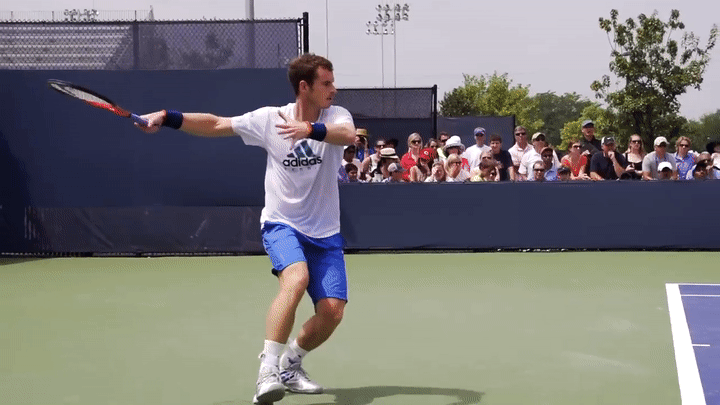
Let’s break it down.
- Preparation, foot position and powerful swing on an arc.
- Arm and Racket Direction is not horizontal but diagonal
- Racket strings (racket head) is is not horizontal but angled down
- Ball launches roughly plus 10deg, with +4000rpm forward rotation
Andy Murray’s Arm Swing
OK, it’s hard to see, even slowed down, I understand that. Let me add some annotations. Let add a 45deg blue line at point of impact.
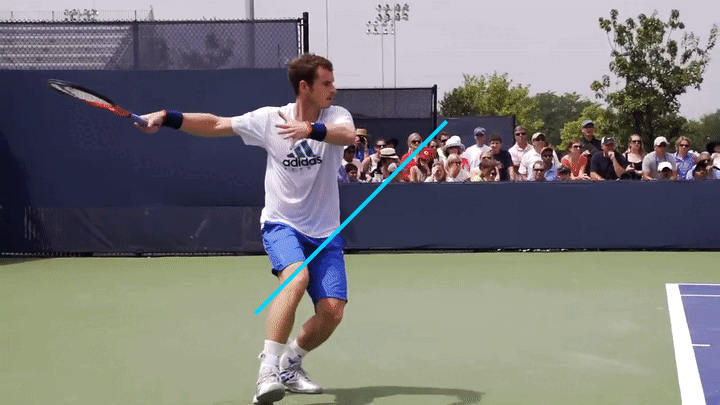
Now do you see his arm and racket movement? On a vertical plane, It follows a diagonal 45 degree line very closely from side it thru the 9 o’clock position through to the 2 o’clock position.
This means all other things being equal he is hitting half up and half forward.
Andy Murray’s Racket Angle
OK, so he hits *hard* at 45 deg (more or less), so why doesn’t the ball fly out of the stadium? It’s because at the same time, he hits down not up like a beginner, or almost flat like an improver. So the racket face is not “open” in the direction of the stroke, but the opposite, its “closed” or more precisely, it is 10–20deg downwards facing. Don’t believe me? Let’s draw a green line, 20deg down from horizon:
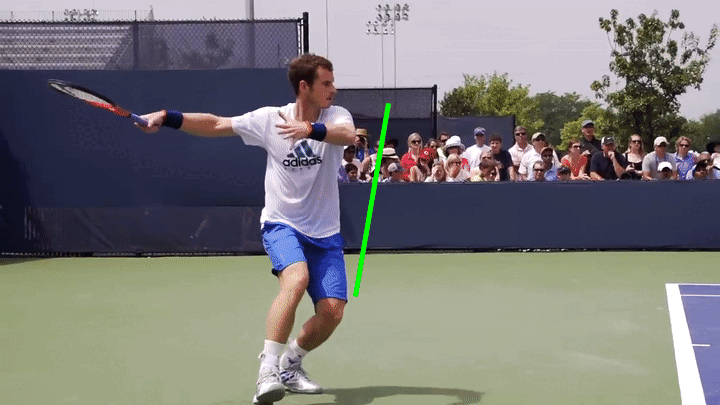
Now do you see the racket face as it hits the ball is 20deg down. In fact, he sets up the racket face as downward facing from way back, and maintains it until the rack is over the shoulder; why? It because the down-angle is so important it’s a core part of the setup and part of years of motor-memory. He doesn’t suddenly aim down at the last millisecond that would be too imprecise, instead he sets up the angle so that the launch angle of the ball is assured even if there is a slight mistiming (in which case the ball would trace a slightly different angle across the court but still go in).
Andy Murray’s Forehand Impact Point
Here I have stopped the video at the point of contact, so you can see that the racket impacts the ball in the middle of the racket and in terms of the ball at around the 9 or 10 o’clock position. If you hit like this the ball’s rebound has a lot of energy and is predictable, if you hit off centre of the racket the rebound in the strings is weak and the ball lacks energy.
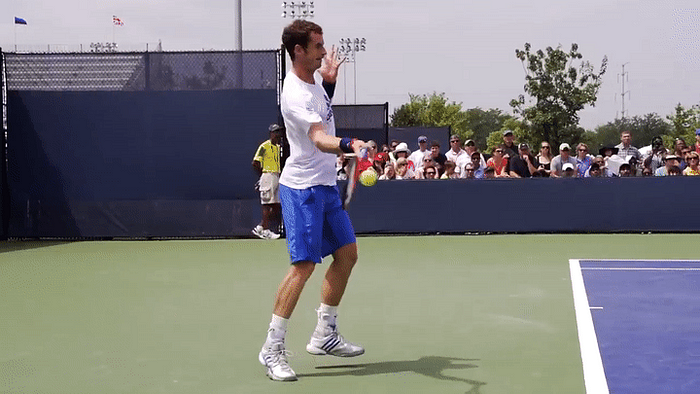
Andy Murray’s Forehand Acceleration
Finally, what you likely missed is not the speed and direction of Andy’s racket but the acceleration of the racket. He accelerates from slow to fast within a 1m swing. You can have big acceleration in a racket that is going really fast or hardly moving at all. Unlike velocity, acceleration is almost invisible, especially if it only lasts a few milliseconds.
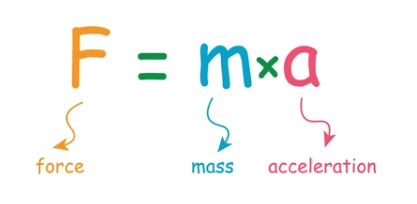
A big acceleration of the racket mass imparts a big force on the ball which is an impulse that changes the speed and direction of the ball in favour of the hitter. The larger the impulse injected into the ball, the more the ball redirects itself in the new orientation ie the direction as the impulse. It doesn’t matter as much what direction the ball was travelling, nor the where the face is pointing. Also even if you stop accelerating stored energy in the strings will be released into the ball delivering impulse and giving you control over its ultimate flight path.
Andy Murray’s Forehand Summary
Wow, there is a lot going on in a fraction of a second but the main takeaways are he is setting up the racket face from behind and keeping orientation steady throughout the stroke. The racket direction (from the side) is half up and half forward; from behind it is a semi-circle (“windscreen wiper”).
The key is that the racket direction and racket head (from top to bottom) are very different and the result is big spin is produced; and the more they are different these angles are then the more spin there is. Similarly the harder the ball is hit then the more the strings deviate, store energy and snap back => more spin again.
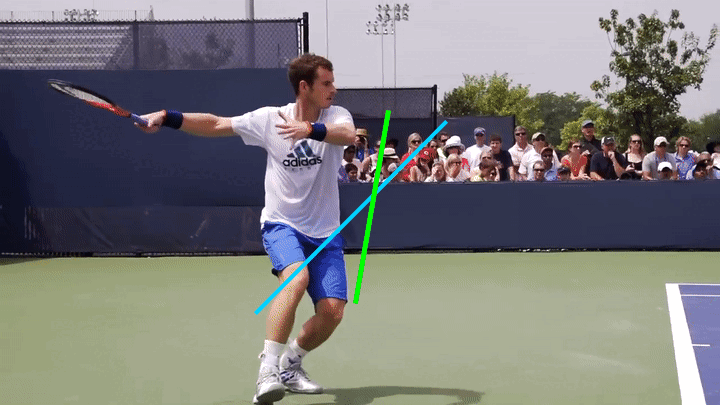
So all this means the more that the angles don’t line up and the harder the ball is hit, the more spin, and the more likely it will go in (for a given speed). Tennis is weird when you break it down like this! Really weird!


